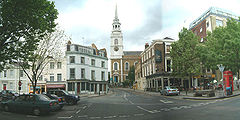St James Clerkenwell
| Clerkenwell | |
|---|---|
 Clerkenwell Green and St James's Church |
|
| Clerkenwell shown within Greater London | |
| Population | 11,490 (2011 Census. Ward) |
| OS grid reference | TQ315825 |
| London borough | |
| Ceremonial county | Greater London |
| Region | |
| Country | England |
| Sovereign state | United Kingdom |
| Post town | LONDON |
| Postcode district | EC1 |
| Postcode district | WC1 |
| Dialling code | 020 |
| Police | Metropolitan |
| Fire | London |
| Ambulance | London |
| EU Parliament | London |
| UK Parliament | |
| London Assembly | |
Clerkenwell (/ˈklɑːrkənwɛl/) is an area of central London in the London Borough of Islington. It was an ancient parish and from 1900 to 1965 formed part of the Metropolitan Borough of Finsbury. The well after which it was named was rediscovered in 1924. The watchmaking and watch repairing trades were once of great importance.
In the 1850s the south-western part of Clerkenwell was known as London's "Little Italy" because around 2,000 Italians had settled in the area. The community had mostly dispersed by the 1960s, but the area remains the 'spiritual home' of London's Italians, and is a focal point for more recent Italian immigrants, largely because of St Peter's Italian Church. There are officially over 200,000 Italians in London, and possibly many more. The Italian Procession of Our Lady of Mount Carmel and Sagra takes place each July in the streets surrounding the church.
A small number of Italian businesses remain from the nineteenth century including organ builders Chiappa Ltd, and food outlets such as the deli Terroni of clerkenwell and Gazzano's. Many other Italian firms survive from the period but have relocated elsewhere.
Clerkenwell took its name from the Clerks' Well in Farringdon Lane (clerken was the Middle English genitive plural of clerk, a variant of , meaning literate person or clergyman). In the Middle Ages, the London Parish clerks performed annual mystery plays there, based on biblical themes. Part of the well remains visible, incorporated into a 1980s building called Well Court. It is visible through a window of that building on Farringdon Lane. Access to the well is managed by Islington Local History Centre and visits can be arranged by appointment.
...
Wikipedia

